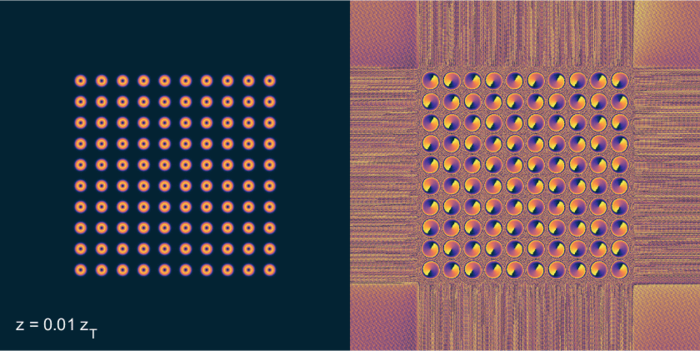Reviewed by Alex SmithApr 12 2022
Twists in fluids may be found in water whirlpools, smoke rings, strong tornadoes and spiral galaxies, all of which are significantly distinct from one another. The research group headed by Antonio Ambrosio at the IIT-Istituto Italiano di Tecnologia (Italian Institute of Technology) in Milano (Italy) has developed similar twists in the world of light.
 Researchers at the Italian Institute of Technology show the realization of coupled light vortices by means of optical metasurfaces. They realized 100 light vortices, coupled to form an ordered structure, a light crystal. The study has been published in the international journal Nature Photonics. Image Credit: IIT-Istituto Italiano di Tecnologia.
Researchers at the Italian Institute of Technology show the realization of coupled light vortices by means of optical metasurfaces. They realized 100 light vortices, coupled to form an ordered structure, a light crystal. The study has been published in the international journal Nature Photonics. Image Credit: IIT-Istituto Italiano di Tecnologia.
The findings, which were published in the international journal Nature Photonics, reveal that 100 light vortices may be connected to form an organized structure called a light crystal.
Antonio Ambrosio, Principal Investigator of the Vectorial Nano-imaging research line at IIT in Milano and grantee of the ERC Consolidator project “METAmorphoses,” is studying the mutual interaction of light and nanostructured materials. Fondazione Cariplo has also contributed to the research.
In recent years, twisted light generators have been created, however, they generally generate a single vortex that propagates alone in free space. Instead, IIT researchers demonstrated that 100 light vortices may be joined together to form an ordered light crystal.
In Milano, the group also comprises Ph.D. student Michael de Oliveira and researcher Marco Piccardo, who is also the paper’s first author. Their findings demonstrate how a nanostructure surface may be used as a mask to alter all of the properties of many laser beams at the same time, not just their intensity.
The researchers demonstrated this by creating an array of metasurfaces, or nanostructured optical devices, that shape the light beam inside a space 100 times smaller than a human hair. The developed metasurfaces create an optical vortex by corkscrewing the wavefront of light.
By placing the metasurface array within a laser cavity, where light bounces back and forth between two mirrors, additional features emerge, such as the capacity to self-heal a system flaw or the ability to change the amount of twists light makes. The interaction between several crystal vortices causes such properties: each vortex is described by the interaction with other vortices in a tunable network.
The metasurface laser’s capacity to modify the number of twists on demand is a unique feature. Although the devices have a set design and can only create one sort of optical vortex in free space, the qualities of the vortices — known as their topology — may be modified by simply tweaking a cavity mirror when they are introduced into a laser cavity.
This capability might be utilized to dynamically modify light in the twists for optical communications, imparting important information.
The Milano system is reliable, and it has the ability to handle data contained in a variety of coupled systems, including distant and massive galaxies. These new findings make it feasible to simulate in the lab complicated linked systems with order disrupted by stable defects, which are otherwise difficult to replicate because they involve massive scales, such as galaxies, or are part of extreme hydrodynamic systems.
The researchers will now look at ways to fine-tune the intensity of the interaction between the vortices and expand the system to include even more vortices.
The study was carried out in partnership with research groups from the IIT in Genova, Italy and the University of the Witwatersrand in South Africa.
Journal Reference:
Piccardo, M., et al. (2022) Vortex laser arrays with topological charge control and self-healing of defects. Nature Photonics. doi.org/10.1038/s41566-022-00986-0.